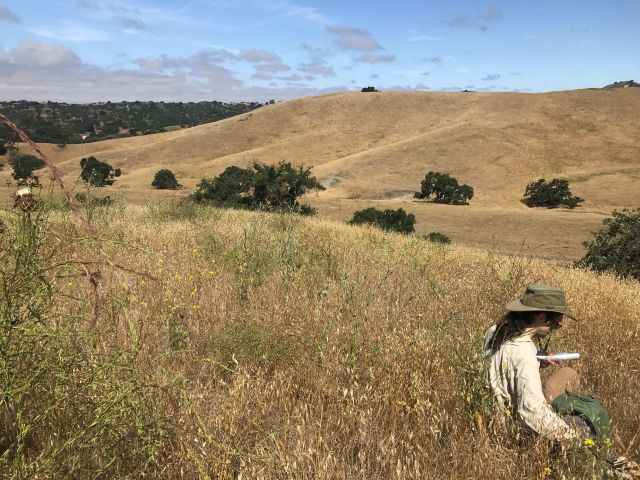Previous Photodegradation Experiments
Photodegradation: Stimulates Microbial Activity Through Enhanced Water Solubility of Grass Litter Carbon
We investigated the production of dissolved organic carbon from photodegraded litter to examine a mechanism of photopriming.
Collaborators: Trevor Romich (M.A. 2020, UC Santa Barbara)
Effects of UV Exposure and Litter Position on Decomposition in a California Grassland
We investigated how ultraviolet (UV) radiation exposure and litter position affected decomposition processes in a California annual grassland. In a split-plot design, we exposed Bromus diandrus litter to two levels of UV radiation (UV pass and UV block) at two aboveground locations (at the top, suspended above the litter layer, and at the bottom of the litter layer) for 1 year. We found that UV radiation increased the litter decay constant by 23% at the top location over 1 year, consistent with the occurrence of photodegradation. Surprisingly, UV radiation also increased the litter decay constant by 30% at the bottom location over 1 year. We speculate that photodegradation indirectly increased microbial decomposition through priming effects. Overall, litter in the top location had a 29% higher decay constant than litter in the bottom location. In terms of litter chemistry, exposure to UV radiation increased loss of hemi-cellulose by 26%, but not loss of lignin. Litter in the bottom location exhibited greater loss of the cell solubles fraction and greater nitrogen immobilization, but lower loss of hemicellulose than litter in the top location. Our results demonstrate that litter position significantly regulates the contribution of photodegradation to overall decomposition, both through direct (top location) and indirect (bottom location) effects. Therefore, better quantification of both direct and indirect effects of photodegradation can greatly improve understanding of biogeochemical cycling in grasslands (see Lin and King, 2014).
Collaborators: Yang Lin (Ph.D. 2015, UC Santa Barbara; now Assistant Professor at University of Florida)
Impacts of Photodegradation on Decomposition of Plant Litter in Arid and Semi-Arid Environments
Results from a 3-year field study in Colorado demonstrate that photodegradation may account for a significant fraction of decomposition in shortgrass steppe (see Brandt et al. 2007). We conducted a large-scale field experiment to examine the importance of photodegradation across a latitudinal gradient at sites in New Mexico, Colorado, and Minnesota. We conducted laboratory experiments to investigate the underlying mechanisms by which solar radiation influences decomposition rates (see Brandt et al. 2009).
Collaborators: Leslie Brandt (Ph.D. 2009, University of Minnesota; now Assistant Director at Office of Sustainability and Climate, USFS), Robert Sinsabaugh (University of New Mexico), Carol Adair (University of Vermont), Daniel Milchunas and William Parton (Colorado State University), Sarah Hobbie (University of Minnesota). Project supported by NSF Ecosystem Science.

